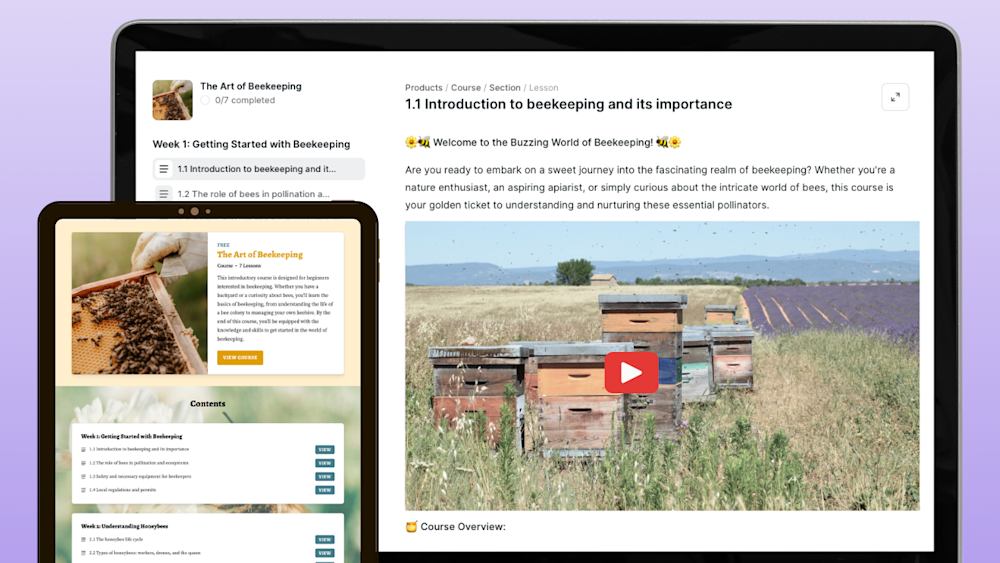In the US alone, roughly half a million people become new business owners every month.
That puts entrepreneurship at a growth rate of 0.31% month-to-month.
With the potential to reward flexibility, freedom, and financial independence, you may be wondering why that rate is so low.
I have a theory.
It’s because starting a new business takes more than hard work and determination. It takes moxie.
And it takes the willingness to wear a new hat every day. 66% of small business owners are responsible for three or more business areas, like sales, marketing, and product development. 56% are responsible for even more than that.
Is it worth it? Absolutely. Wearing all of those hats helped Nick Stephenson pull in $130,208 in course sales within his first week of launching.
And it can help you do the same. Today, we’ll talk about five actionable tips for a profitable course launch so you can land your first sale like Nick.
The first one may surprise you. What’s the key to a great product launch? Start selling before you have the product.
Tip #1: Sell first, build later
Does the idea of cold calling potential clients make you break out in a cold sweat?
You’re not alone. Trying to reach customers is a nightmare for everyone, with sales reps reporting as much as 40% of their day can be spent looking for someone to call.
Fortunately, you can bypass cold-calling and cold-emailing by finding your first prospects before you’ve built your course.
Pre-selling your course helps clear the debris from the sales road and provides a clear path to profits by validating your idea before you ever start your journey.
Zoe Linda, online course leader, recalls skipping this step as a big mistake with her first course:
“Because I didn’t validate my idea, I wasn’t seeing any interest from my community. Their silence spoke volumes about their lack of interest in my course idea.”
Nick Foy echoes her sentiment, explaining, “You want to make sure your course idea will sell before you spend all the time, money, and energy making it.”
And last but never least, the numbers back them both up. The reason most startup businesses fail? Overwhelmingly, it’s because there’s no market need for their product.
42% of startups cite a lack of market need as the nail in their coffin.
So validating and pre-selling your course isn’t just necessary for raking in sales after launch, it’s also crucial for guiding your course creation process in the first place. (Plus, it's a good way to jump-start your business and stop procrastination in its tracks.)
Pre-selling their course helped ProBlogger net almost 5,000 sign-ups for their first course. Of those 5,000, over 1,000 became active students.
It also helped Molly Marie Keyser’s first course generate almost $10,000 a day within her first week of launch.
But if you’ve already launched your course and are worried you can’t capitalize on this strategy, have no fear.
Using validation testing helped one course creator transform her flop to a $12,000 victory in a few months.
And, here’s the really great news:
It’s super easy to set up your course idea on your Podia website. Check out how Full Circle Music uses this feature for their upcoming course “Song Chasers.”
Here’s how to set your course up for a pre-launch. First, head over to your product dashboard.
Click “Create” and choose “Online course,” fill in the text fields, and then click “Create product”.
Once you’ve added all of your content (if any), look up in the top right corner and click the down arrow under “Draft.” From there, choose the middle option.
And just like that, you have a course page ready to capture emails and start generating interest.
Here’s a peek at the finished product:
From here, you can start spreading your course sign up page on social media and through online communities to get feedback from your potential audience.
Quora, Reddit, and SlideShare are all excellent platforms to connect with learners and easy to get started with.
But if you really want to see your audience grow and validate your course idea, use our next tip to engage and convert all at once.
Tip #2: Use webinars to convert
Amy Porterfield champions webinars as more than a marketing strategy for pulling in conversions: they’re an entire system for bringing in sales.
The numbers back her up, too.
Consider this: Continuing education and training webinars have some of the highest conversion rates from registrant-to-attendee at 40% and 45%, respectively.
Webinars are also one of the highest converting lead generation tactics used by professional marketers, converting attendees to qualified leads at a rate between 20-40%.
Jenna Soard used two educational webinars to pull in $17,000 in sales with audiences of less than 100 people.
They can do more than just one-time sales, too. Webinars are great for building evergreen content and long-lasting promotion.
Check out how Traffic Generation Cafe’s one-time webinar continues to pull in potential customers as a lead magnet (more on this later).
Hugh Culver, bestselling author and mega-successful entrepreneur, explains the power of webinars for course builders:
“You have their complete attention. You can try new material, test their response and – even better – build rapport with your audience and build demand for your new course.”
WebinarNinja is easy to use and comes loaded with a ton of marketing materials, like sign-up and thank you pages, out of the box.
You can set up a webinar in less time than it takes to find a new binge-worthy series on Netflix. Here’s how.
First, slide over to WebinarNinja.
Click one of the two “start free trial” buttons.
You’ll be taken to the pricing page. Since our goal is your first sale, let’s choose the “starter” package for now.
Go ahead and finish signing up for an account. It should only take a minute.
Once you’re done, pop over to your email inbox to validate your account and sign back into WebinarNinja.
This is your dashboard. There’s a lot of interesting nooks and crannies to check out, but for now, proceed by clicking the “Create New Webinar” button.
Fill in your details. Since we’re just setting this up as a test, feel free to set it up for any time. (I probably wouldn’t recommend 2 AM for your real webinar, though.)
After you’ve scheduled your webinar, you can edit it by clicking either the blue “Go To My Webinars” button or selecting the play icon in the left-hand navigation menu.
Here’s our “My Webinars” page. Use the drop-down menu under “Options” to change your settings, including editing your registration pages and viewing your statistics.
Once you are happy with your settings, click "Publish" and your webinar will be ready for the world!
When you’re ready to go live with your webinar, click ‘Enter Studio” and get ready to engage.
Alternatively, if you’re looking for platforms with free plans and Podia integration, there’s also join.me and Zoom.
But although these options won’t cost you, you’ll lose out on marketing materials, so it’s worth considering a premium package if webinars become a staple for your sales strategies.
(Looking for even more webinar tips? Check out this article on the 7 most common webinar mistakes and how to avoid them.)
After you’ve held your webinar, turn it into free promotion and use it to build your audience with our next tip.
Tip #3: Create free content
Creating free content, even free courses, is an excellent strategy for growing your audience in preparation for your first sale.
At the very least, creating a lead magnet or opt-in freebie will help you build your email list, so you have leads ready to sell to when your course launches.
What makes content a good lead magnet? Mainly, how valuable it is to your audience.
Check out HubSpot’s most popular lead magnets in 2017:
Your webinar from our last tip is already a ready-made lead magnet for you if you’ve enabled replays.
Plus, it’s already aligned with your potential buyers, something 87% of professional content creators struggle with, putting you ahead of your competition.
From here, it’s just about creating more relevant content to add value and prove your mettle to your leads.
And, if possible, this should happen before you’re finished building your course.
Vladimir Polo, CEO and founder of AcademyOcean, is a big believer in this approach, highlighting the value of developing your content before your course:
“You get data on course content (and you can better understand what information is interesting to your target audience and, on the other hand, what information doesn’t draw them in).”
He’s not the only one, either. Luisa Zhou used content to prove the value of her services and courses, helping her make $1.1 million in sales in less than a year.
Let’s check out how other creators are leveraging free content to boost their sales pages.
Brit Poe, business coach and success strategist, provides writers with a free, short course on all the ins-and-outs of a creative writer’s toolset.
By giving users a chance to get familiar with her teaching style and providing a practical, high-value course, Brit successfully positions her paid courses as worth the upgrade for hesitant leads.
Eldar Gezalov uses this strategy as well.
Like Brit, Eldar’s free course is a short, audience-relevant offering that provides users interested in Blocs with actionable advice and content.
For anyone interested in the subject, they can check out his videos and get to know his expertise firsthand before committing to his paid courses.
The key word to remember for your free content is actionable.
What Brit and Eldar both do with their free courses is help their viewers in concrete ways, soothing the pain points common to their audience.
So no matter what you create, make sure your free content provides viewers with the tools they need to fix their frustration.
Do that, and like Michael Corleone, your audience will have an offer too good to refuse.
Tip #4: Beef up your product pages
Does your product page have a FAQ? If not, you may be missing out on the chance for your first conversion.
We surveyed 100 popular online courses and found 75% of their sales pages had a FAQ section.
FAQ sections can not only help land your first sale, but they can make future sales go a lot smoother.
You can put it directly on your Podia course pages, too.
Peep how Pixel Vision 8 Fantasy Console uses one on their Game Creator Pro page.
By answering questions directly on the product page, they help address any confusion or uncertainty about their product out of the gate.
Similar to Brit and Eldar, this FAQ is useful and focused on providing value to the user by explaining the specifics of the course.
Felicia Pride adopts this approach as well for The Creative Comeback.
Adding a FAQ to your product page isn’t just useful for users, either.
It’s good for your conversions, too.
How good? Adding product FAQs directly to their product pages helped Roller Skate Nation increase their conversions by 69%.
So a little preemptive question-and-answer on your part is definitely profitable.
But don’t limit yourself to just talking about the product. Include a refund policy on your FAQ as well to reduce visitor anxiety and encourage sales.
After all, almost 67% of shoppers will check out your return policy before they make a purchase.
Ebay surveyed the relationship between conversions and return policies on their platform.
The results? Pretty awesome. Adding a 30-day free return can lift your conversions by a whopping 15%.
Returns are even easier for you since there’s no return shipping or restocking to worry about with online courses.
Nicole Saidy includes a quick note in her FAQ directly on the page to assuage viewers’ concerns about her return policies.
Simple and conversationally written, her return policy lets viewers know her biggest concern is with their satisfaction and personal growth.
Robert Joyner uses an even simpler approach, providing a friendly, clear-cut return policy for his courses.
Humorous and easy to understand, Robert’s return policy is as clean as it comes.
To get started on your own, check out this excellent guide and template.
For our final tip, we’ll talk about one way to launch your course to fewer people for more sales.
Tip #5: Soft launch your course
Have you heard 90% of new businesses fail?
If so, you can take a sigh of relief.
Education and health are among the most forgiving industries for new businesses. Comparatively, only 44% of startups in the education and health industries bite the dust.
What makes education so resistant?
Because unlike most industries, educators are always willing to – unsurprisingly – learn more and do more.
One of the ways this is done is through beta or pilot testing programs before releasing them.
Think of it as the digital equivalent to someone cooking and saying, “Come here and try this” before serving dinner.
Beta launches are another pre-launch strategy, but unlike our first tip, they come after your course is built. These are the finishing touches, making sure the seasoning is just right on your course.
Beta launches and/or pilot tests can be as simple as a few distilled modules you offer for free or at a deep discount to get direct feedback from customers.
Pilot tests get their start from instructional design, where they’re considered an integral part of the educational development process.
This is probably why so many instructional designers who work with online course creators espouse the virtues of beta testing.
Coleen Stanley, an instructional designer with hundreds of online courses under her belt, sings this strategy’s praises:
“...one of the single most effective steps in having a successful online course launch that brings many of the aforementioned possibilities (and profits) is to beta test your online course first.”
Janelle Allen, another instructional designer and course consultant, concurs and advises new course creators to use their beta test as an opportunity to gather customer testimonials before they launch, as well.
(Just make sure your reviews disclose any discounts the customer may have received in exchange for their feedback.)
ConvertKit recommends doing your beta test two months out from your official launch.
Pilot tests can bring in their own slush fund, too. One creator pulled in over $10,000 in profits with a 26-member pilot group for his upcoming online learning program.
Regina Anaejionu used a soft launch to begin building profits while continuing to polish her product, earning $1350 with her first launch, then an additional $1,000 monthly until she was ready for a “hard” launch.
So, how do you get beta members on board? There are two methods.
You can let users sign up directly for your mailing list to become a beta member, as Blog Biz School does on their Podia site.
Or, if you created a free course from our third tip, you can use Podia’s awesome email campaigns to invite those leads to enlist as beta-testers.
Here’s a quick template you can use to get the ball rolling and recruit customers for your beta test.
Beta List Template
Hi there,
I’ve been working on launching an all-new course on [subject area], but I need your help. I saw you downloaded my [Free Course/Free Content Lead] and want to offer you an exclusive opportunity to influence my next project.
Here’s the breakdown:
Cost: [Price]
Date: [Beta release date]
All I ask in return is that you provide me your honest feedback so I can make my next course even better than the last.
Sound good? If you’re interested, just reply to this email, and I’ll add you to my secret list.
Thank you in advance!
– [Your Name]
Who wouldn’t want to sign up for that?
Just remember, whether the results of your beta test come back with major renovations or quick ten minute fixes, every step forward in your journey is one step closer to your first sale – and even better – to your first satisfied customer.
Conclusion
Is your first sale eluding you? If so, follow these five tips to find leads and meet your first customer.
-
One of the most popular strategies for a profitable course launch is to sell it before you’ve built it. Validate your idea with potential customers first to make sure there’s a market for your product.
-
Part of building an online course is creating great videos, so why not make it part of your marketing, too? Use webinars to hook people’s interest and start converting.
-
Free content and courses are another excellent strategy for pulling in sales – just make sure your content is jam-packed with so much value the user can’t wait to get their hands on an upgrade.
-
Add a FAQ and your return policy directly to your product pages to increase your sales and decrease user anxiety – a win-win for everyone.
-
Soft-launch your course and run a beta test to work out all the kinks in the line before you make an official launch. Not only can this lead to your first sale, but it can also make your future products stronger and even more gush-worthy.
Launching your first online course can call for a daunting ensemble of hats – from manager, to sales rep, to marketer, to product developer – but with a little moxie and hard work, you’ll be shaking digital hands with your first learner, and then your hundredth, before you know it.



